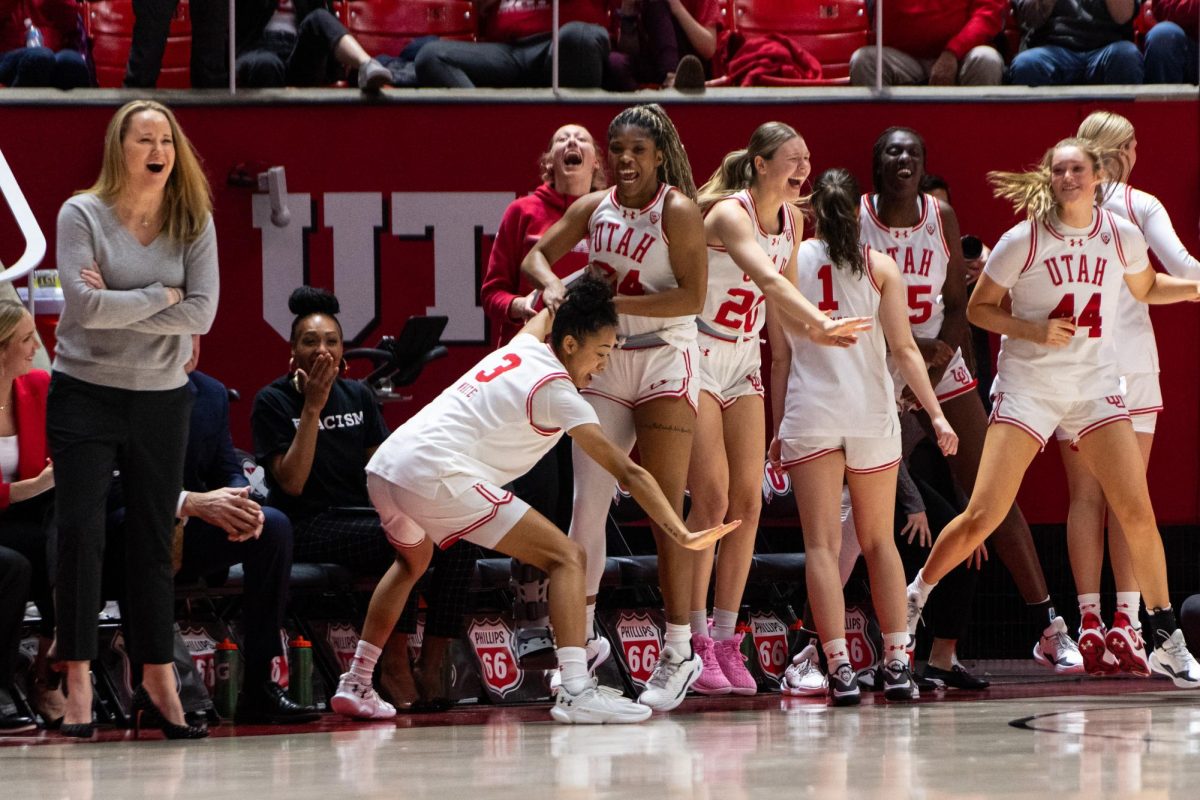Leadoff Versus Anchor: How Both Change Gymnastics
University of Utah women’s gymnastics junior Sydney Soloski talks to sophomore Hunter Dula before her performance on the uneven bars in a dual meet vs. the Stanford Cardinal at the Jon M. Huntsman Center in Salt Lake City on Friday, March 6, 2020. (Photo by Kiffer Creveling | The Daily Utah Chronicle)
March 30, 2020
One of the most important aspects of gymnastics is the lineup. Whether it is the leadoff, the anchor or somewhere in the middle, every gymnast has a job to do — build on the score before theirs.
There are two position spots that seem to carry pressure beyond building scores — the leadoff and the anchor. One University of Utah gymnast, Sydney Soloski, was both an anchor and a leadoff during the 2020 season.
The leadoff sets the tone for the whole rotation, so many coaches tend to put one of their most consistent athletes for the event in that spot.
“You want your leadoff most likely to be the most consistent person on their team, so that they can put everyone after them kind of at ease that they’re not stressed going in,” Soloski said.
According to head coach Tom Farden, the leadoff is someone that the team believes in. He looks for performers who can reliably start things out on the right foot.
“Your leadoff person is so critical, you’ve got to be somebody that the team has embraced as dependable and gets the team going. You know, whether it be with Sydney Soloski coming off a stick on vault or Emilie [LeBlanc] leading on the intricate events, she’s been trustworthy,” Farden said.
From the leadoff spot, scores tend to grow. As the team makes their way down the lineup, the quality of routines goes up, and the scores tend to rise with the difficulty. According to Farden, there is competition within the lineups.
According to Soloski, the leadoff tends to be the person with the simplest routine, and as they get deeper into a rotation, the scores tend to go up based on difficulty.
“A lot of the time, it’s just the nature of the routine and the fact that you’re going first. They [the judges] are hesitant to give you the big score, but you’re also not necessarily earning the 9.95 what you’re doing, but it’s not impossible,” Soloski said.
Soloski says that building up the scores from leadoff through anchor shows how consistent a team is. She also says that posting a strong leadoff score is great news for the team, especially because if things go awry somewhere else in the rotation, the leadoff score is counted.
“The leadoff is definitely a crucial building point,” Soloski said. “That’s why it’s hard when you have a fall, especially if you have a fall in your leadoff position. It’s stressful, but it’s not detrimental because you can start building from two to six. Whereas if you have a fall, spot number two, spot number three, that’s when it makes it really hard.”
Soloski believes that the anchor spot is the position that could be the most stressful for a gymnast.
“When you’re the leadoff, even if you fall like yeah, that sucks and you feel responsible, but you don’t have to go again. Whereas the anchor, you are dealing with every single person that came before you,” Soloski said. “You’re seeing the scores popping up, and especially when you have someone fall, you’re responsible to clean up that mess. Whereas when you’re the leadoff, yes, it’s stressful because you don’t want to add stress to anyone else, but your job is your job, and then if you mess it up, it’s everyone else’s problem to deal with.”
When it comes to making his lineups, each event coach at Utah has a say about who will get the go-ahead, but at the end of the day, Farden has the final word. He says that nine times out of ten he and the event coaches are on the same page about who will perform.
“I’ve had the final say for the past five years on what lineups we’re going to put out there. One of our greatest rubrics that we use is we’ve got to come up with a lineup that’s going to give us some max points,” Farden said.








